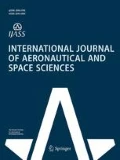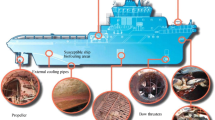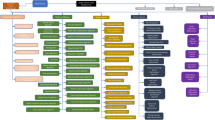Abstract
In the present study, a CFD-based database is proposed to predict surficial pressure loading. To evaluate flow properties, a three-dimensional multi-phase Navier–Stokes flow solver based on unstructured meshes was utilized. Relative motion between a platform and a projectile was described using six degrees of freedom (6-DOF) equations of motion and an overset mesh technique. Accuracy of the 6-DOF module in the flow solver was validated by solving a benchmark problem. Four major parameters related to the surficial pressure loading were selected, which are escaping velocity, pressure of compressed gas flows, freestream velocity, and depth of water. Initial sample points were estimated by applying an improved Latin hypercube sampling method. To evaluate a flow condition with the maximum surficial pressure loading in a given database, a genetic algorithm and an artificial neural network were utilized. Then, accuracy of the database was iteratively evaluated by comparing the maximum pressure loading with those by the CFD prediction. It was found that the relative errors are less than 0.1% for both the projectile and the platform with 24 resultant sample points. It was also found that the escaping velocity and the freestream velocity significantly affect the characteristics of the surficial pressure loading due to the rotational disturbance around the projectile.










Similar content being viewed by others
Abbreviations
- D :
-
Projectile diameter, m
- \( \vec{F},\;\vec{G} \) :
-
Flux vectors
- F :
-
Force, N
- I :
-
Moment of inertia, kg-m2
- m :
-
Mass, kg
- M :
-
Moment, N-m
- \( \vec{n} \) :
-
Normal vector
- p, q, r :
-
Angular velocity, rad/s
- P :
-
Pressure, Pa
- \( \vec{Q} \) :
-
Vector of conservative variables
- t :
-
Time, s
- u, v, w :
-
Linear velocity, m/s
- \( \alpha_{\text{l}} \) :
-
Liquid volume fraction
- \( \beta \) :
-
Artificial compressibility
- \( \varGamma \) :
-
Preconditioning matrix
- \( \mu \) :
-
Viscosity, kg/m-s
- \( \rho \) :
-
Fluid density, kg/m3
- \( \tau \) :
-
Pseudo-time
- \( \phi ,\;\theta ,\;\psi \) :
-
Euler angles, degree
- \( \phi_{j} \) :
-
Gaussian function in jth order
- \( \varOmega \) :
-
Arbitrary computational domain
- l :
-
Liquid
- v :
-
Vapor
- \( \infty \) :
-
Freestream
References
Laughlin JP, Brooks WB (1996) Adaptation of the army tactical missile system to undersea operations. Lockheed Martin Vought Systems Corporation, Grand Prairie
Ahn SJ, Kwon OJ (2013) Numerical investigation of cavitating flows for marine propulsors using an unstructured mesh technique. Int J Heat Fluid Flow 43:259–267. https://doi.org/10.1016/j.ijheatfluidflow.2013.05.007
Chorin AJ (1967) A numerical method for solving incompressible viscous flow problems. J Comput Phys 2(1):12–26. https://doi.org/10.1006/jcph.1997.5716
Stewart HB, Wendroff B (1984) Two-phase flow: models and methods. J Comput Phys 56(3):363–409. https://doi.org/10.1016/0021-9991(84)90103-7
Kunz RF, Boger DA, Stinebring DR, Chyczewski TS, Lindau JW, Gibeling HJ, Venkateswaran S, Govindan TR (2000) A preconditioned Navier–Stokes method for two-phase flows with application to cavitation prediction. Comput Fluids 29(8):849–875. https://doi.org/10.1016/S0045-7930(99)00039-0
Blazek J (2001) Computational fluid dynamics: principles and applications. Elsevier, Oxford
Roe PL (1981) Approximate Riemann solver, parameter vectors and difference. J Comput Phys 43(2):357–372. https://doi.org/10.1016/0021-9991(81)90128-5
Mathur SR, Murthy JY (1997) A pressure-based method for unstructured meshes. Numer Heat Transf Part B Fundam 31(2):195–215
Spalart PR, Allmaras SR (1992) A one-equation turbulence model for aerodynamic flows. In: Proceedings of the 30th aerospace sciences meeting and exhibit, Reno, NV
Reboud JL, Stutz B, Coutier O (1998) Two phase flow structure of cavitation: experiment and modeling of unsteady effects. In: Proceedings of the 3rd international symposium on cavitation, Grenoble, France
Venkatakrishnan V (1995) Convergence to steady state solutions of the Euler equations on unstructured grids with limiters. J Comput Phys 118(1):120–130. https://doi.org/10.1006/jcph.1995.1084
Jung MS, Kwon OJ (2007) A parallel unstructured hybrid overset mesh technology for unsteady viscous flow simulations. In: Proceedings of the 15th international conference on parallel computational fluid dynamics, Antalya, Turkey
Nelson R (1998) Flight stability and automatic control. McGraw Hill, New York
Holland JH (1992) Genetic algorithm. Sci Am 267(1):66–72. https://doi.org/10.1038/scientificamerican0792-66
McCulloch WS, Pitts W (1943) A logical calculus of ideas immanent in nervous activity. Bull Math Biophys 5(4):115–133. https://doi.org/10.1007/BF02478259
Broomhed DS, Lowe D (1988) Radial basis function, multi-variable functional interpolation and adaptive networks. Technical Report RSME Memorandum, Royal Signals and Radar Establishment, No. 4148
Huntington DE, Lyrintzis CS (1998) Improvements to and limitation of Latin hypercube sampling. Probab Eng Mech 13(4):245–253. https://doi.org/10.1016/S0266-8920(97)00013-1
Lijewski LE, Suhs NE (1994) Time-accurate computational fluid dynamics approach to transonic store separation trajectory prediction. J Aircr 31(4):886–891. https://doi.org/10.2514/3.46575
Acknowledgements
This work was conducted at High-Speed Vehicle Research Center of KAIST with the support of Defense Acquisition Program Administration (DAPA) and Agency for Defense Development (ADD).
Author information
Authors and Affiliations
Corresponding author
Rights and permissions
About this article
Cite this article
Jo, S.M., Lee, H.M. & Kwon, O.J. Prediction of Surficial Pressure Loading for an Underwater Projectile Using CFD-Based Database. Int. J. Aeronaut. Space Sci. 19, 618–625 (2018). https://doi.org/10.1007/s42405-018-0071-x
Received:
Revised:
Accepted:
Published:
Issue Date:
DOI: https://doi.org/10.1007/s42405-018-0071-x




